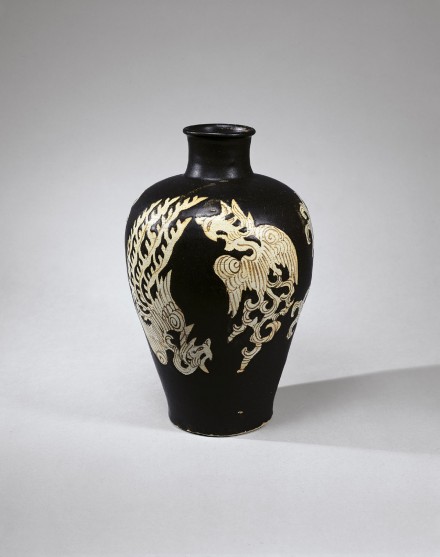J.J. Lally & Co., Oriental Art / New York City, New York
MenuPast Exhibition
Chinese Ceramics in Black and White
March 20–April 10, 2010

26.
A JIZHOU BLACK-GLAZED STONEWARE
‘DOUBLE PHOENIX’ MEIPING
Southern Song Dynasty (A.D. 1127–1279)
of well-potted baluster form with high rounded shoulders surmounted by a slightly waisted cylindrical neck with wide mouth and rolled-out rim, boldly decorated with two matching pairs of fenghuang, one pair on the front and the other pair on the back, the male phoenix in each pair shown descending with four long serrated tail feathers displayed, the female phoenix flying in the opposite direction with shorter scrolling tail feathers, and with twin curling cloud motifs separating the pairs of phoenixes, the decoration produced by cut paper stencils applied before glazing and removed before firing, the designs enhanced by brushed-on details in dark-brown slip and covered with a clear glaze, the rest of the vase covered with a rich dark brown-black glaze which thins to coffee-brown inside the neck and continues over the recessed flat bottom, the edge of the sturdy wedge-shaped ring foot wiped clean of glaze revealing the pale ivory-tan colored stoneware.
Height 111⁄4 inches (28.5 cm)
From the Collection of Mr. and Mrs. Yeung Wing Tak, Hong Kong
Published
Black Porcelain from the Mr. and Mrs. Yeung Wing Tak Collection, Guangzhou, 1997, pp. 35–36, no. 16
A very similar meiping in the collection of the Harvard University Art Museums is illustrated by Mowry in Hare’s Fur, Tortoiseshell and Partridge Feathers: Chinese Brown- and Black-Glazed Ceramics, 400–1400, Cambridge, 1996, pp. 253–255, no. 103, where the author assigns this type of vase to the kilns at Yonghe, Ji’an, Jiangxi province and describes the deriva- tion of the design, origins of the form and technology of the decoration. A detail of one of the phoenixes from the same meiping is illustrated on the covers of the catalogue.
Another meiping of this form and design, from the T. T. Tsui Collection is illustrated in the catalogue of the exhibition shown at the Art Gallery of the University of Hong Kong, Exhibition of Art Treasures from Shanghai and Hong Kong, Hong Kong, 1996, p. 106, no. 40.
南宋 吉州黑釉剔花雙鳳梅瓶 高 28.5 厘米
26.
A JIZHOU BLACK-GLAZED STONEWARE
‘DOUBLE PHOENIX’ MEIPING
Southern Song Dynasty (A.D. 1127–1279)
Height 111⁄4 inches (28.5 cm)